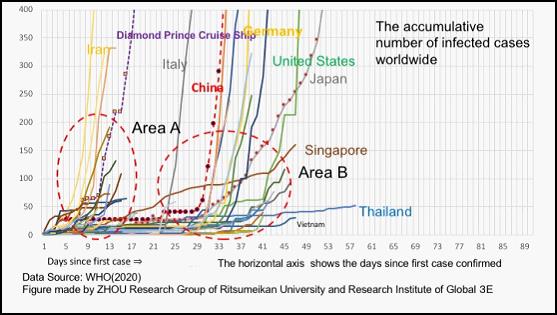




- BRNN
- BRI News
- BRNN News
- Database
Official Documents Polices and Regulations
Inter-government Documents International Cooperation BRI Countries
Business Guide Economic Data BRI Data
Trade
Investment Projects Latest projects
Cases - Content Pool
"COVID-19 is the biggest crisis the world has faced since World War Ⅱ.” Dr. Zhou Weisheng, a Professor from College of Policy Science, Ritsumeikan University said in an interview with Science and Technology Daily.

Dr. Zhou believes that the spread of COVID-19 further proves that we live a community of shared future for mankind with common benefits and risks. In order to achieve the goal of maximizing the benefits and minimizing the risks, international cooperation and mutual support are required in both prevention and control of the pandemic and the protection of the global industrial chain.
China's experience has raised alerts from two aspects for the world
Zhou said that since the outbreak of COVID-19, the efforts and spirit of the Chinese people, such as the spirit of self-sacrifice, perspective of overall situation and coordinated actions, have shown the strength of the Chinese people with solidarity, and won a great amount of time for the world to contain the spread of the COVID-19.
At the same time, Dr. Zhou noted, China has raised alerts from two aspects for the world from the statistical results.
First, during the battle against COVID-19, China obtained the first-hand pathological data, which made the world well-informed about the fact that COVID-19 was spreading around the world extremely quickly; Second, China had to take the strictest measures to prevent and control the situation through city lockdown, which has alarmed the world by these bold measures.
China has won the world time to combat COVID-19 with first-hand experience
Viruses know no national borders, and many countries had experienced infectious disasters in the past. Dr. Zhou also emphasized that China has made contribution to the world.
The first one is to gain time for the world to prepare for dealing with COVID-19. Zhou Weisheng's lab is carrying out research on the policy initiatives of various countries since the beginning of the epidemic. His research team aims to sum up experience and lessons through quantitative analysis for better prevention in the future.
Zhou made a detailed introduction on the results of his research that there are two Modes of outbreak. Mode A (Area A) is the Cruise Ship Mode (such as Diamond Princess cruise ship, which refers to the rapid outbreak of infection in areas with high population density). And Mode B (Area B) is the Urban Mode (Wuhan in China, Italy, etc.). From the statistical analysis, in Mode A, the incubation period from the detection of the first infected case to the outbreak of infection is about 7 days. When it comes to Mode B, the incubation period from the detection of the first infected case to the outbreak of infection is about 30 days. That is to say, it is extremely important to take decisive measures within one month after the discovery of the first infected case.



According to the World Health Organization's timeline against COVID-19, on December 31, 2019, Wuhan Municipal Health Commission in China reported a cluster of pneumonia cases in Wuhan, Hubei Province. A novel coronavirus was eventually identified. And on January 23, 2020, China took a series of decisive prevention and control measures, which marked by Wuhan lockdown. In the face of this previously unknown pandemic, China has tried its best to fight against COVID-19 without any delay.
Wu Zunyou, chief epidemiologist at the Chinese Center for Disease Control and Prevention, noted that China reported information to the World Health Organization regarding the outbreak (January 3). In the same day, China began to inform the United States about the pneumonia of unknown cause. Starting from January 3, China has been regularly informing the WHO, relevant countries and regions about the pneumonia of unknown cause. On January 12, China shared the genome sequences of the novel coronavirus with WHO and other countries in a timely manner, Wu also said.
In response to COVID-19, China has promptly released relevant information, shared experience and promoted international cooperation in an open, transparent and responsible manner.
Sino-US cooperation is the 'best option' for all
In that urgent scenario, China had no previous experience to draw on and had to take prevention and control measures with careful trials. However, some countries could take measures in their own way while referring to China's experience.
US now has most COVID-19 cases in the world, with more than one million confirmed cases.
"As the world's largest developed country, the United States should have guided and supported the world in the effective prevention and control on the basis of China's experience. Some countries have underestimated the importance of China's experience in preventing the spread of novel coronavirus,” Dr. Zhou said.
He sincerely hopes that China and the United States could not only fight against COVID-19 for their own people, but also work together to lead the world, especially developing countries, out of difficulties and overcome the catastrophic challenge.
“Determining the origin and route of the infection of novel coronavirus requires scientific and objective research. The region where the infection information was firstly publicly disclosed is not necessarily the origin of the novel coronavirus. Because it is possible that other affected areas have not been announced or the patients in these areas have been treated for other diseases such as influenza. Searching the origin of novel coronavirus should be supported by solid scientific evidence and intensive research. Every country in the world shares the same responsibility," Dr. Zhou Weisheng emphasized in the end.

Tel:86-10-65368972, 86-10-65369967